4 Types of Data Analytics (Techniques & Real-Word Examples)

According to data analytics statistics, 328.77 million terabytes of data are created every day. But the only thing that can turn this data into actionable information is data analytics. It helps businesses gain clarity from mounds of data in order to make more informed decisions. However, what is data analytics, exactly?
What is Data Analytics in Simple Words?

Data analytics is the process of collecting, inspecting, transforming, modeling, and analyzing raw data to uncover meaningful patterns and insights and identify trends. It involves applying various statistical modeling and mathematical techniques and leveraging advanced algorithms and technology to extract valuable information from large and complex datasets.
Data analytics assists enterprises and organizations with a variety of tasks, such as:
- Making informed decisions
- Identifying opportunities
- Solving challenges
- Optimizing procedures
Businesses gain a competitive advantage, drive innovation, improve efficiency, and ultimately achieve their goals by leveraging the power of data analytics in the constantly changing and data-driven economy.

Who Needs Data Analytics?
Data analytics has become an indispensable tool for professionals in various roles. Its capacity to harness the power of big data and turn it into actionable intelligence is critical for success in the data-driven business world. Specialists from almost all industries can benefit from data analytics.
Executives and business leaders
- Acquire a comprehensive understanding of business operations, customer behavior, and the dynamics of the market.
- Find the patterns, trends, and possibilities to make strategic choices.
- Ensure optimization of business development and profitability by making informed decisions.
Marketing professionals
- Maximize the effectiveness of marketing efforts by defining the target audience.
- Tailor messaging to the targeted demographics for higher engagement and conversion rates.
Operation managers and supply chain experts
- Streamline operations and boost productivity with data-driven insights.
- Reduce expenses by locating bottlenecks and optimizing stock levels.
Financial analysts and risk managers
- Analyze data to assess market conditions and find irregularities.
- Make informed investing decisions and reduce imminent risks.
Let's begin our journey toward the four (4) types of data analytics, where big data stimulates informed decisions and transformative results.
Types of Data Analytics for Improved Decision-Making
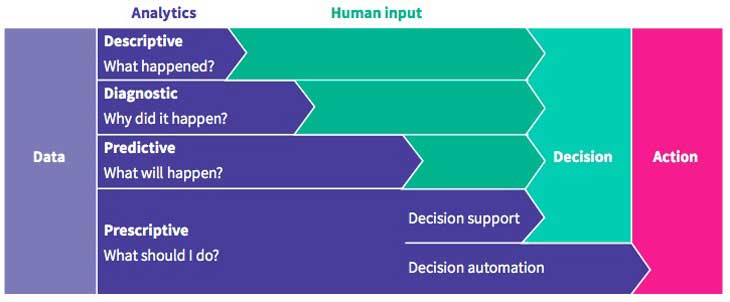
1. Descriptive Analytics
Descriptive analytics answers the question, “What happened?” It involves collecting and organizing data, conducting calculations, and presenting the results in a meaningful format, such as reports, dashboards, or visualizations. The primary objective is to provide a clear and concise summary of historical data so that stakeholders can comprehend trends, patterns, and key performance indicators.
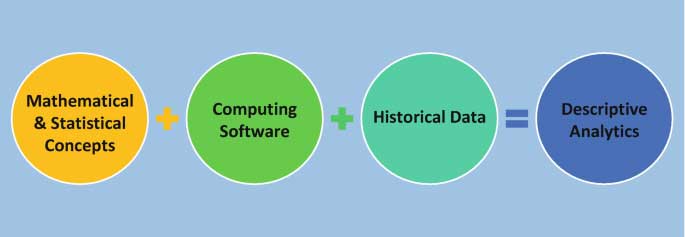
Descriptive Analytics Techniques
Descriptive analytics encompasses various techniques, including:
- Data Visualization: Using data visualization tools and presenting data using charts, graphs, and other visual formats for easier interpretation.
- Key Performance Indicators (KPIs): Identifying and tracking metrics that reflect the performance of specific areas or processes.
- Trend Analysis: Examining big data over time to identify patterns, cycles, or fluctuations.
- Horizontal Analysis: Horizontal analysis of financial statements compares historical financial data of businesses. It is vital to identify trends, changes, and patterns in the performance of a company.
- Cohort Analysis: Cohort analysis helps organizations understand and track the behaviors, patterns, and trends of a specific group over time.
Benefits of Descriptive Analytics in Decision-Making
Descriptive analytics provides several key benefits:
- Historical Perspective: By analyzing past data, organizations can gain a deeper understanding of their performance, customer behavior, and market trends.
- Data-Driven Insights: Descriptive analytics helps identify patterns, correlations, and anomalies in the data, leading to actionable insights.
- Benchmarking and Comparison: Descriptive analytics lets companies compare their performance to industry norms or competitors and identify strengths and weaknesses.
- Risk Identification: Decision-makers can proactively address these risks, mitigating potential threats and minimizing negative impacts.
Real-World Applications
- Various Retail Stores: Descriptive analytics uses descriptive analysis to analyze data for sales, identify popular products, track seasonal trends, and optimize inventory management.
- Healthcare Sector: It can help analyze patient records, monitor disease patterns, and identify areas for improving healthcare outcomes.
- Financial Services: Descriptive analytics can assist in analyzing customer data, detecting fraudulent activities, and identifying market trends for investment decisions.
2. Diagnostic Analytics
Diagnostic analytics address the “Why did it happen?” question. It entails a thorough diagnostic analysis of data to identify patterns, industry trends, and anomalies, followed by an investigation of the core variables that contributed to those patterns. By scrutinizing the cause-and-effect relationships within the data, organizations can comprehend the underlying factors behind certain outcomes.
Diagnostic Analytics Techniques
Diagnostic analytics encompasses various techniques, including:
- Data Mining: Uncovering hidden patterns and relationships within large relational databases.
- Root Cause Analysis: Identifying the underlying factors that led to a particular event or outcome.
- Correlation Analysis: Examining data by determining the strength and nature of relationships between variables.
- Hypothesis Testing: Formulating and testing hypotheses to validate causal relationships.
- Comparative Analysis: Comparing data between groups or segments to identify differences and potential causes.
Benefits of Diagnostic Analytics in Decision-Making
Diagnostic analytics provides several key benefits:
- Identification of Key Drivers: Organizations can identify the crucial factors that influence specific outcomes, helping them prioritize areas for improvement or intervention.
- Problem-Solving: Diagnostic analytics helps uncover the root causes of issues or challenges, enabling organizations to develop targeted solutions.
- Performance Optimization: By understanding the reasons behind successful outcomes, organizations can replicate and optimize those conditions for future success.
- Data-Driven Decision-Making: This data analytics type provides evidence-based insights that support informed decision-making and minimize guesswork.
Real-World Applications
- Customer Churn Analysis: Diagnostic analytics can help identify factors contributing to customer churn by analyzing customer behavior, preferences, and satisfaction data.
- Quality Control: It can investigate production issues and identify the root causes of quality defects, leading to process improvements.
- Supply Chain Optimization: Diagnostic data analytics can uncover bottlenecks, delays, or inefficiencies in the supply chain, allowing organizations to streamline operations.
3. Predictive Analytics
Predictive analytics seeks to answer the question, “What is likely to happen?” It involves evaluating historical data, recognizing patterns, and constructing models to predict future outcomes or behaviors. Utilizing statistical models and sophisticated algorithms, organizations can optimize their strategies by making data-driven decisions accompanied by proactive measures.
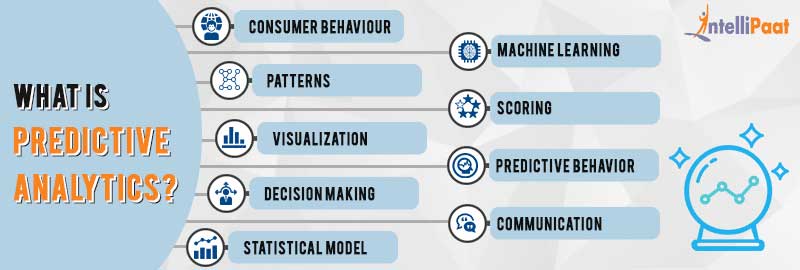
Predictive Analytics Techniques
Predictive data analytics encompasses various techniques, including:
- Regression Analysis: Predicting a continuous variable based on relationships with other variables.
- Time Series Forecasting: Predict future trends’ values based on historical patterns and trends.
- Classification Models: Assigning data points to predefined categories.
- Machine Learning Algorithms: Leveraging algorithms such as random forests, support vector machines, or neural networks for predictive models.
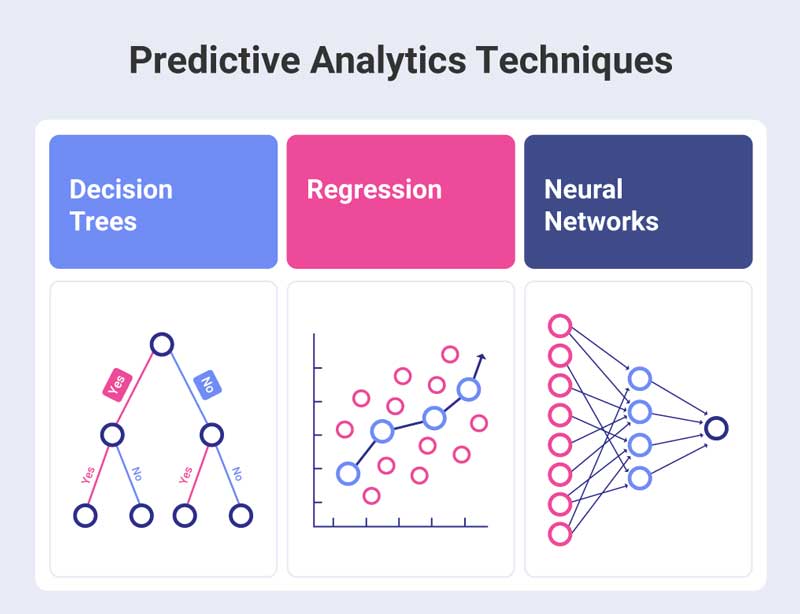
Benefits of Predictive Analytics in Decision-Making
Predictive analytics provides several key benefits:
- Proactive Decision-Making: By forecasting future outcomes, organizations can proactively optimize strategies, mitigate risks, and seize opportunities.
- Enhanced Resource Allocation: Predictive analysis helps firms allocate resources by forecasting demand, optimizing inventory, and predicting maintenance.
- Customer Behavior Prediction: It helps organizations understand customer preferences, predict buying patterns, and personalize offerings, leading to better customer engagement and satisfaction.
- Risk Assessment: Predictive data analytics helps companies reduce losses by recognizing risks, fraud, and creditworthiness.
Real-World Applications
- Financial Forecasting: Predictive models help budgeting and financial planning by predicting sales, revenue, and expenses.
- Demand Forecasting: It assists businesses in predicting future demand for their products and services, thereby optimizing production, inventory, and supply chain management.
- Healthcare Diagnosis: Predictive data analytics can help with disease diagnosis and prognosis by analyzing past medical records and patient demographics.
4. Prescriptive Analytics
Prescriptive analytics finally focuses on answering the question, “What should we do?” It gives suggestions and strategies that can be used to make better decisions. Prescriptive data analytics helps companies predict future trends by taking into account different constraints, goals, and resources. Choose wisely and act in ways that bring about the desired outcomes.
Prescriptive Analytics Techniques
Prescriptive analytics encompasses various techniques, including:
- Decision Trees: Analyzing possible decision paths and outcomes to recommend the best course of action.
- Optimization Models: Using mathematical optimization techniques to determine the optimal allocation of resources and maximize desired outcomes.
- Simulation Models: Simulating various scenarios and evaluating the impact of different business decisions to identify the best strategy.
- Recommendation Engines: Leveraging machine learning algorithms to provide personalized suggestions based on user preferences and historical data.
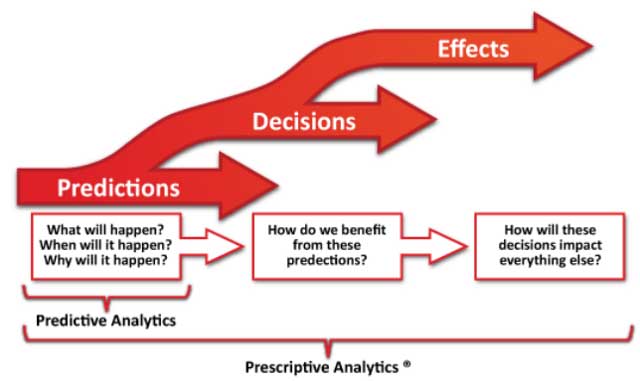
Benefits of Prescriptive Analytics in Decision-Making
Prescriptive data analytics provides several key benefits:
- Informed Decision-Making: It provides organizations with data-backed recommendations, reducing uncertainty and enabling better data-driven decision-making.
- Optimal Resource Allocation: Prescriptive data analytics assists in optimizing resource allocation, such as budget, workforce, and inventory, to achieve desired outcomes.
- Risk Mitigation: By simulating different scenarios, organizations can identify potential risks, evaluate mitigation strategies, and make decisions that minimize risks.
- Continuous Improvement: Prescriptive analytics allows organizations to continuously refine and optimize their strategies based on real-time data and feedback.
Real-World Applications
- Supply Chain Optimization: Prescriptive data analytics can optimize inventory levels, transportation routes, and production schedules to enhance supply chain efficiency and reduce costs.
- Energy Management: It helps organizations optimize energy consumption, determine optimal usage patterns, and identify opportunities for energy savings.
- Healthcare Treatment Planning: Prescriptive analytics assists in determining the most effective treatment plans for patients based on their medical history, symptoms, and other data.
Conclusion
Leveraging the power of analytics is paramount for informed decision-making. From descriptive analytics providing historical insights to prescriptive analytics, every type suggests actionable takeaways that organizations can use to unlock the true potential of big data.
By utilizing these four types of data analytics, businesses can gain a competitive edge, drive growth, and confidently navigate the complexities of today's dynamic landscape. Embracing data analytics is not just a trend but a strategic imperative for success in the ever-evolving digital world.
Explore Further
- 30 Best Business Intelligence and Analytics Software Tools
- The Ultimate List of Big Data Statistics
- Must-Know Machine Learning Statistics
- Data Analytics Statistics. The Whole Industry at Glance
- Artificial Intelligence Statistics to Blow Your Mind
- 23 Best Data Visualization Tools of 2023